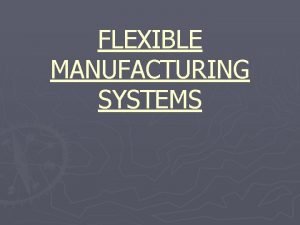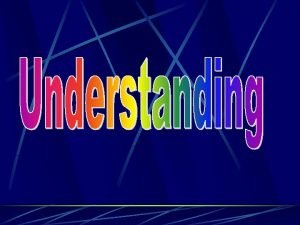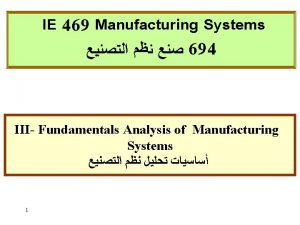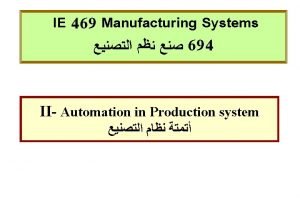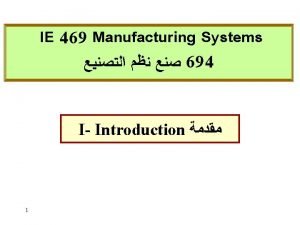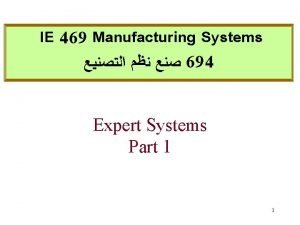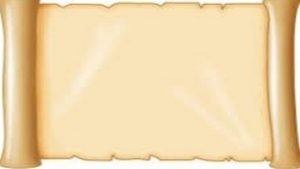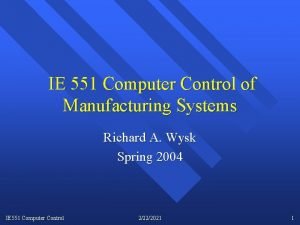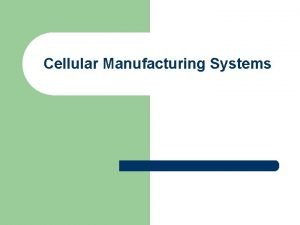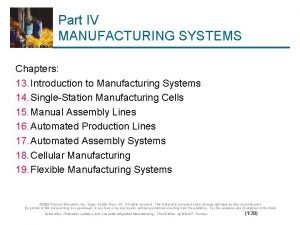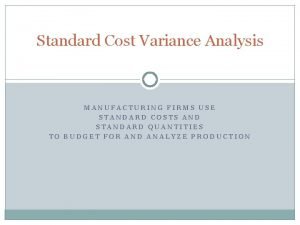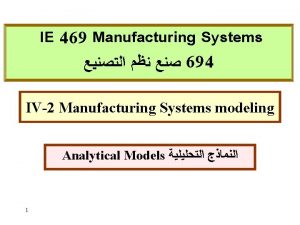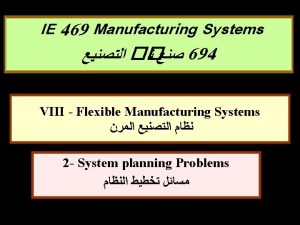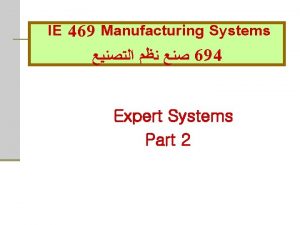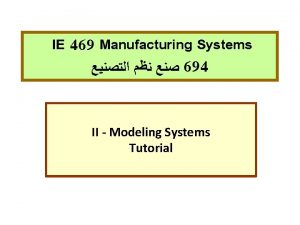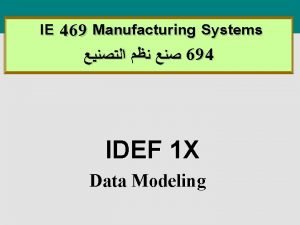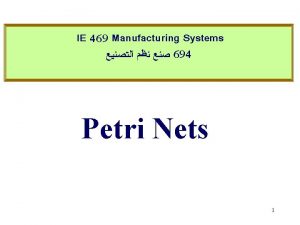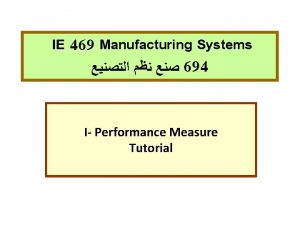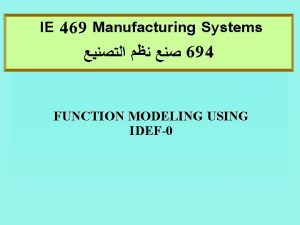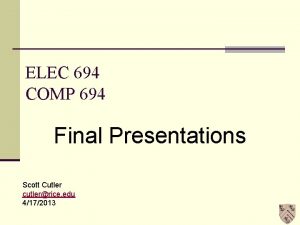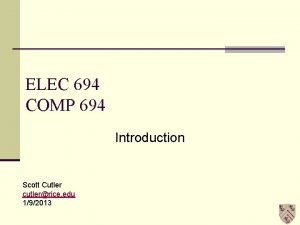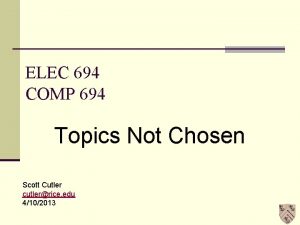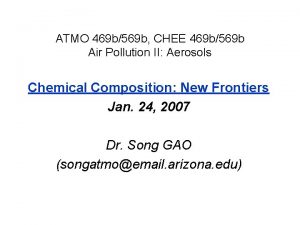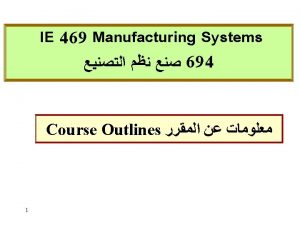IE 469 Manufacturing Systems 694 III Fundamentals Analysis






































- Slides: 38

IE 469 Manufacturing Systems ﺼﻨﻊ ﻨﻈﻢ ﺍﻟﺘﺼﻨﻴﻊ 694 III- Fundamentals Analysis of Manufacturing Systems ﺃﺴﺎﺳﻴﺎﺕ ﺗﺤﻠﻴﻞ ﻧﻈﻢ ﺍﻟﺘﺼﻨﻴﻊ 1



1 b- Principle Laws of Mfg System ﺃﺴﺎﺳﻴﺎﺕ ﻗﻮﺍﻧﻴﻦ ﻧﻈﺎﻡ ﺍﻟﺘﺼﻨﻴﻊ 1 st principle ﺍﻷﺴﺎﺱ ﺍﻷﻮﻝ : - Little Law ( Work in Process) WIP = Rp x T = Production Rate x Throughput Time X per Time 1 0 2 1/X 3 2/X …………… N-2 N-1 N-3/X N-2/X N N-1/X X per Time N/X FINISH Time 2 nd principle ﺍﻷﺴﺎﺱ ﺍﻟﺜﺎﻧﻲ : - Conservation of Matter Input = Output Raw Material Equipment Tooling & Fixture 4 Energy Labor Good /service Manufacturing Process Scrap/Defective Waste: Chips/Tools



1 e- Principle Laws of Mfg System ﺃﺴﺎﺳﻴﺎﺕ ﻗﻮﺍﻧﻴﻦ ﻧﻈﺎﻡ ﺍﻟﺘﺼﻨﻴﻊ 3 rd Principle ﺍﻷﺴﺎﺱ ﺍﻟﺜﺎﻟﺚ : - Exponential growth in complexity The interconnections between system components in a network grow faster with the increases of the components number and their states Possible states = NM Possible linkage between components = M(M-1)/2 M = Number of components N = Number of states of a component ﻟﻠﻌﻼﻗﺔ ﺑﻴﻦ ﺍﻟﻤﻨﺘﺠﺎﺕ ﺍﻟﻤﻄﻠﻮﺏ ﺗﺼﻨﻴﻌﻬﺎ 4 th principle ﺍﻷﺴﺎﺱ ﺍﻟﺮﺍﺑﻊ : - System Reliability As system becomes larger, it becomes Less Reliable (difficult to design, coordinate, and maintain). 7 r 1 ﻭﻳﺼﻤﻢ ﺍﻟﻨﻈﺎﻡ ﺍﻟﺼﻨﺎﻋﻲ ﻭﻋﻤﻠﻴﺎﺗﻪ ﻛﺪﺍﻟﺔ ﻭﺍﻹﻧﺘﺎﺝ r 2 …… ri …… r N-1 r. N

1 f- Principle Laws of Mfg System ﺃﺴﺎﺳﻴﺎﺕ ﻗﻮﺍﻧﻴﻦ ﻧﻈﺎﻡ ﺍﻟﺘﺼﻨﻴﻊ 5 th Principle ﺍﻷﺴﺎﺱ ﺍﻟﺨﺎﻣﺲ : - Object Decay System components behavior can not kept constants with time or could be exactly the same when replaced. (i, . e. bearing wear or gear wheel replacement of a machine changes the machine behavior and could not be the same. This affect the system performance. ) 6 th Principle ﺍﻷﺴﺎﺱ ﺍﻟﺴﺎﺩﺱ : - Random Behavior of system Components Inherently stochastic behavior of system Components or complex to understand system, system events are not precisely predicted, (i. e. Cutting fluid condition- Breakdown behavior of each machine -Repair time of each machine- etc). Statistical distribution and Probability analysis of each 8 component is required.

1 g- Principle Laws of Mfg System ﺃﺴﺎﺳﻴﺎﺕ ﻗﻮﺍﻧﻴﻦ ﻧﻈﺎﻡ ﺍﻟﺘﺼﻨﻴﻊ 7 th Principle ﺍﻷﺴﺎﺱ ﺍﻟﺴﺎﺑﻊ Obsolescence : - Technology Advances and As the system components Technology develop, the system becomes obsolete before decaying. This changes the nature of system production and performance (i. e. Loss of market due to loss ofthquality or response of delivery). 8 Principle ﺍﻷﺴﺎﺱ ﺍﻟﺜﺎﻣﻦ : - Limit on (Human) Rationality The limit of memory, experience, and capability and the change of natural characteristics with time limit the realization of optimality and tend to solve for satisfaction only at the time. 9 th Principle ﺍﻷﺴﺎﺱ ﺍﻟﺘﺎﺳﻊ Tasks : -Combining/Simplifying/Eliminating The tasks analysis and design are principle in providing gains 9 in time saving, money, and energy. Thus increasing productivity, quality, and reducing cost could be achieved.

2 - Decision Framework ﻫﻴﻜﻞ ﺍﻟﻘﺮﺍﺭ ﻟﻨﻈﺎﻡ ﺍﻟﺘﺼﻨﻴﻊ ﻫﻮ ﺍﻟﺒﻨﻴﺔ ﺍﻟﺘﻲ ﺗﻜﻮﻥ ﻣﺠﻤﻮﻋﺔ ﻣﺨﺘﺎﺭﺓ ﻣﻦ ﺍﻟﻤﺘﻐﻴﺮﺍﺕ : Decision Framework ﻫﻴﻜﻞ ﺍﻟﻘﺮﺍﺭ ﻭﺗﺘﻜﻮﻥ ﻫﺬﻩ ﺍﻟﺒﻨﻴﺔ , ﻭﺍﻟﺼﻔﺎﺕ ﺍﻟﻘﺮﺍﺭﻳﺔ ﺍﻟﺘﻲ ﺗﺼﻒ ﺍﻟﻨﻈﺎﻡ ﻭﺗﻌﺒﺮ ﻋﻦ ﺧﺼﺎﺋﺺ ﺍﻟﺘﺼﻤﻴﻢ ﻭﺍﻟﺘﺸﻐﻴﻞ ﻣﻦ ﺛﻼﺙ ﻣﻜﻮﻧﺎﺕ ﻛﻤﺎ ﻓﻲ ﺍﻟﺸﻜﻞ ﺍﻟﻤﺮﻓﻖ Flexibility Process Decision making Process: • Mapping: Attributes levels are related to different levels variables • Simultaneous. Optimization of attributes and trade off between them Quality Equipment System Manufacturing requirement Specified as Decision Variables (i. e. 10 Speed-Feed-defect) Cost Time Performance requirement Specified as Decision Attributes (Measurable Parameters) ( Benefit Measures: Higher is better) (Cost Measures: lower is better)








3 -2 a-Models of Measurable Parameters ﻧﻤﺎﺫﺝ ﻭﺣﺪﺍﺕ ﺍﻟﻘﻴﺎﺱ 1 -Manufacturing Lead Time 18

3 -2 b-Models of Measurable Parameters ﻧﻤﺎﺫﺝ ﻭﺣﺪﺍﺕ ﺍﻟﻘﻴﺎﺱ 2 -Production Time and Production Rate 19

3 -2 c-Models of Measurable Parameters ﻧﻤﺎﺫﺝ ﻭﺣﺪﺍﺕ ﺍﻟﻘﻴﺎﺱ 3 - Plant Capacity: Max. rate of output= Number of good units produced period. (i. e. period; week) 20

3 -2 d-Models of Measurable Parameters ﻧﻤﺎﺫﺝ ﻭﺣﺪﺍﺕ ﺍﻟﻘﻴﺎﺱ 4 - Utilization: The amount of a production facility relative to its capacity 5 - Availability: A measure of reliability for equipment and expressed as percentage 21

3 -2 e-Models of Measurable Parameters ﻧﻤﺎﺫﺝ ﻭﺣﺪﺍﺕ ﺍﻟﻘﻴﺎﺱ 6 - Work-In-Process (WIP): The amount of product currently located in the factory that is either being processed or is between processing operations. WIP is inventory that is in the state of being transformed from raw material to finished product. Machine Time 5% Operation Time 30% 22 Moving and waiting Time 95% Positioning, loading , gauging. . Time 70% Time Spend by A part in Batch production shop

3 -2 f-Models of Measurable Parameters ﻧﻤﺎﺫﺝ ﻭﺣﺪﺍﺕ ﺍﻟﻘﻴﺎﺱ 6 - Work-In-Process (WIP): Two measures can be used to assess the magnitude of the WIP. 6 a-(WIP) Ratio: An indicator for the amount of inventory-in-process relative to the work actually being processed. The ideal ratio = 1 For high volume production: WIP ratio close to 1, ignoring raw material waiting to be launched into line & Finished Product waiting to be distributed. For Batch Production: WIP ratio close to 50 or higher, depending on the batch 23 size, nonproductive time, and other factor in the plant.

3 -2 g-Models of Measurable Parameters ﻧﻤﺎﺫﺝ ﻭﺣﺪﺍﺕ ﺍﻟﻘﻴﺎﺱ 6 b-(TIP) Ratio: An indicator for the time that the product spends in the plant relative to its actual processing time. The ideal ratio = 1 For high volume production: TIP ratio close to 1, ignoring raw material waiting to be launched into line & Finished Product waiting to be distributed. For Batch Production: TIP ratio close to 20 or higher, depending on the batch size, nonproductive time, and other factor in the plant. 24

3 -3 a-Models of Cost Parameters ﻧﻤﺎﺫﺝ ﻭﺣﺪﺍﺕ ﺍﻟﻘﻴﺎﺱ 7 - Cost in Manufacturing: The cost composed of several costs Profit Increase Sale Price Distribution • Market Analysis: Value Analysis Competition Fixed Costs Investment Holding Variable Costs Labor Material 25 Setup Total Mfg Cost (TC) Overhead Total Production Cost Sales Price Storage Increasing Profit Increase Market • Market Analysis: Reduce Total Cost • Product Design: Value Analysis • Work Design: Method Study Automation

3 -3 b-Models of Cost Parameters ﻧﻤﺎﺫﺝ ﻭﺣﺪﺍﺕ ﺍﻟﻘﻴﺎﺱ Usually, cost is expressed in uniform annual cost (UAC) or cost per time period considering time value of the cost. The Total Cost: Typical Factory Overhead Expenses 26 Fixed Cost Typical Corporate Overhead Expenses

3 -4 -Models of Parameters averages ﻧﻤﺎﺫﺝ ﻭﺣﺪﺍﺕ ﺍﻟﻘﻴﺎﺱ 9 - Calculation of Equations Variables: For actual factory data, variations in parameter values are inherence. Therefore, Averaging of these values may be computed using straight arithmetic and weighted averaging. 27

4 a- Mfg System Problems ﻣﺴﺎﺋﻞ ﻧﻈﺎﻡ ﺍﻟﺘﺼﻨﻴﻊ Manufacturing systems are designed and operating based on three planning issues to be solved as follows: : ﺗﺨﻄﻴﻂ ﺍﺳﺘﺮﺍﺗﻴﺠﻲ Strategic Planning ﺗﺨﻄﻴﻂ ﺗﻜﺘﻴﻜﻲ Tactical Planning ﺗﺨﻄﻴﻂ ﺗﺸﻐﻴﻠﻲ Operational Planning ﺍﻷﺪﺍﺀ ﺗﻘﻴﻴﻢ 28 Performance Evaluations : ﺗﺼﻤﻴﻢ ﺍﻟﻨﻈﺎﻡ Justification • ﺍﻟﺘﺒﺮﻳﺮ Design • ﺍﻟﺘﺼﻤﻴﻢ Installation • ﺍﻟﺘﺮﻛﻴﺐ : ﺍﻹﻧﺘﺎﺝ ﺧﻄﻂ Batching • ﺍﻟﻤﺠﻤﻮﻋﺔ Loading • ﺍﻟﺘﺤﻤﻴﻞ Routing • ﺍﻟﻤﺴﺎﺭ : ﺧﻄﻂ ﺍﻟﺘﺸﻐﻴﻞ Sequencing • ﺍﻟﺘﺴﻠﺴﻞ Scheduling • ﺍﻟﺠﺪﻭﻟﺔ Dispatching ﺍﻻﺭﺳﺎﻝ •










 Opwekking 694 tekst
Opwekking 694 tekst Manufacturing systems modeling and analysis
Manufacturing systems modeling and analysis Manufacturing cost vs non manufacturing cost
Manufacturing cost vs non manufacturing cost Job costing vs process costing examples
Job costing vs process costing examples Controllable expenses examples
Controllable expenses examples Manufacturing cost vs non manufacturing cost
Manufacturing cost vs non manufacturing cost Additively
Additively Hamlet act iii scene ii
Hamlet act iii scene ii Irc 469
Irc 469 Section 469 material participation
Section 469 material participation Ee 469
Ee 469 ıe469
ıe469 Ie469 bilkent
Ie469 bilkent Cs 469
Cs 469 Cs 469
Cs 469 Socrates 469-399 bce
Socrates 469-399 bce Ie 469
Ie 469 469 rounded to the nearest hundred
469 rounded to the nearest hundred Ie469
Ie469 Ie 469
Ie 469 Ie 469
Ie 469 Ie 469
Ie 469 Ie 469
Ie 469 469 - 399
469 - 399 Computer control of manufacturing systems
Computer control of manufacturing systems Opitz coding system
Opitz coding system Introduction to manufacturing systems
Introduction to manufacturing systems Fundamentals of information systems 9th edition
Fundamentals of information systems 9th edition Fundamentals of information systems 9th edition
Fundamentals of information systems 9th edition Fundamental of information system
Fundamental of information system Dc/ac fundamentals a systems approach
Dc/ac fundamentals a systems approach Fundamentals of information systems chapter 1
Fundamentals of information systems chapter 1 Fundamentals of information systems
Fundamentals of information systems Fundamentals of information systems 9th edition
Fundamentals of information systems 9th edition Quality management systems fundamentals and vocabulary
Quality management systems fundamentals and vocabulary Pmt 0140 team management and leadership exam
Pmt 0140 team management and leadership exam Standard cost vs budgeted cost
Standard cost vs budgeted cost Manufacturing cost variance analysis
Manufacturing cost variance analysis Hilbert space
Hilbert space

